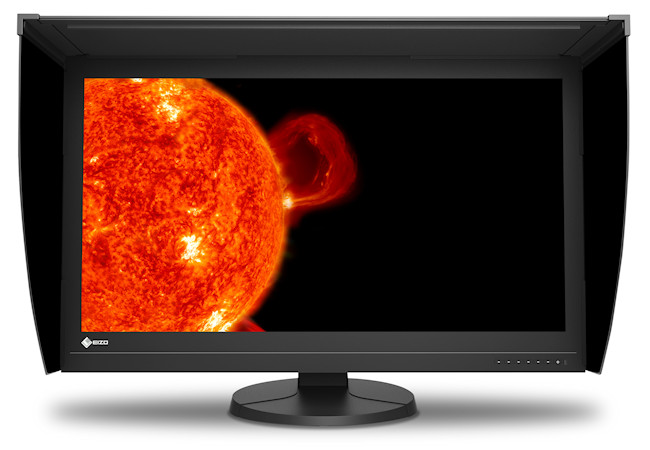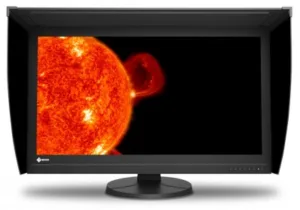We had a chance for a pre-IBC look at the new ColorEdge Prominence CG3145 HDR monitor from Eizo that was previewed at NAB. The monitor is now coming to market with shipments expected to start globally in November. The monitor was getting a lot of interest at the show – this was the first time that the company had been on its own booth at the event.
The CG3145 uses the Panasonic 4096 x 2160 1,000,000:1 and 1,000 cd/m² of brightness, using an IPS panel that is backed with a monochrome second layer LCD that modulates the backlight at the pixel level to achieve the deep blacks similar to that of OLEDs, but without the same problems with very bright screens. Color gamut is 99% of DCI P3.
 In the back of the booth Eizo was showing the CG3145 alongside a Sony Broadcast OLED. Image:Meko
In the back of the booth Eizo was showing the CG3145 alongside a Sony Broadcast OLED. Image:Meko
The company, bravely, had the monitor in a darkened room alongside a Sony BVM broadcast OLED monitor. When the image was quite dim, the Eizo matched the Sony, but as the amount of bright content on the display rose, the Sony started to suffer, with the white point shifting towards blue. At a certain point, the Sony’s ABL circuitry cuts in and a small light on the control panel comes on, which indicates to the viewer that it is in operation and may be compromising the image quality.
One of the disadvantages of the dual LCD system is that there can be some viewing angle issues, so Eizo has developed a special algorithm that slightly blurs the backlight to reduce the effect and so it can be switched in our out – out when grading and in when a grade needs to be shown to a client or other creative.
The monitor will cost €20,000.
Analyst Comment
I mentioned this monitor to a number of people at the event and several were going to look at it. Side by side with the Sony, it looked very surprisingly good. I think it’s the first time I have ever seen anything that can come close to the contrast of OLEDs. I didn’t find the viewing angle issues a problem, but I’m not a ‘golden eyes’ grader! I did like the high level of brightness when there was a lot of bright content on the display. Effectively, the monitor adds the high ‘colour volume’ that Samsung has been promoting for its QLED TVs, to the black levels of OLED.
Of course, the monitor is not a broadcast monitor – there are no SDI inputs and other features such as waveform monitors are not present, although apps such as Premiere, Vegas and Resolve support these functions. The monitor needs to be connected to a PC, unlike traditional broadcast products. Ikegami had one of those, using the panel, at the show.
The biggest downside of the monitor is probably that it is quite inefficient and there is a deep backlight. The LEDs need to be run hard and Eizo told us that it has a ‘kind of AI’ to manage the backlight over its lifetime and at different temperatures.
When we saw the monitor before the show, the company didn’t have a figure for power, but on the website the maximum is 472W, with a typical value of 267W. (BR)

